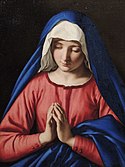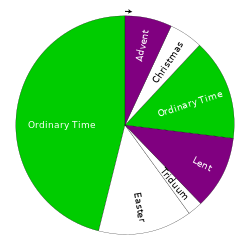Assumption of Mary
| Assumption of the Blessed Virgin Mary | |
|---|---|
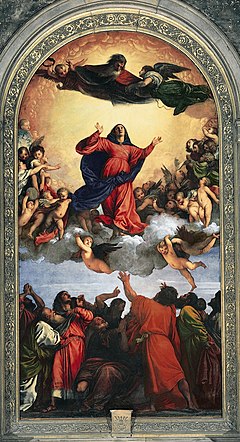 A famous treatment in Western art, Titian's Assumption, 1516–1518 | |
| Also called |
|
| Observed by | |
| Type | Christian |
| Significance | The bodily taking up of Mary, the mother of Jesus into Heaven |
| Observances | Attending Mass or service |
| Date |
|
| Frequency | Annual |
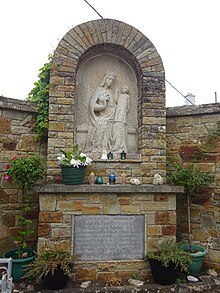
The Assumption of Mary is one of the four Marian dogmas of the Catholic Church. Pope Pius XII defined it on 1 November 1950 in his apostolic constitution Munificentissimus Deus as follows:
We pronounce, declare, and define it to be a divinely revealed dogma: that the Immaculate Mother of God, the ever-Virgin Mary, having completed the course of her earthly life, was assumed body and soul into heavenly glory.
— Pope Pius XII, Munificentissimus Deus, 1950[2]
It leaves open the question of whether Mary died or whether she was raised to eternal life without bodily death.[3]
The equivalent belief in the Eastern Christianity is the Dormition of the Mother of God or the "Falling Asleep of the Mother of God".
The word 'assumption' derives from the Latin word assūmptiō, meaning 'taking up'.
Pope Pius XII expressed in his encyclical Munificentissimus Deus the hope that the belief in the bodily assumption of the virgin Mary into heaven "will make our belief in our own resurrection stronger and render it more effective",[4] while the Catechism of the Catholic Church adds: "The Assumption of the Blessed Virgin is a singular participation in her Son's Resurrection and an anticipation of the resurrection of other Christians."[5]
Traditions relating to the Assumption
[edit]In some versions of the assumption narrative, the assumption is said to have taken place in Ephesus, in the House of the Virgin Mary. This is a much more recent and localised tradition. The earliest traditions say that Mary's life ended in Jerusalem (see Tomb of the Virgin Mary).[6]
According to the Passing of the Blessed Virgin Mary, attributed to Joseph of Arimathea, which is a later version of the Virgin Mary's Dormition, probably from sometime after the early seventh century, one of the apostles, often identified as Thomas the Apostle, was not present at the death of Mary but his late arrival precipitates a reopening of Mary's tomb, which is found to be empty except for her grave clothes.[7] Finally, Mary drops her girdle down to the apostle from heaven as testament to the event.[8] This incident is depicted in many later paintings of the Assumption.
Teaching of the Assumption of Mary became widespread across the Christian world, having been celebrated as early as the 5th century and having been established in the East by Emperor Maurice around AD 600.[9] In a homily, John Damascene (675–749 AD), citing the third book of the Euthymiac History, records the following:
St. Juvenal, Bishop of Jerusalem, at the Council of Chalcedon (451), made known to the Emperor Marcian and Pulcheria, who wished to possess the body of the Mother of God, that Mary died in the presence of all the Apostles, but that her tomb, when opened upon the request of St. Thomas, was found empty; wherefrom the Apostles concluded that the body was taken up to heaven.[10][11]
History
[edit]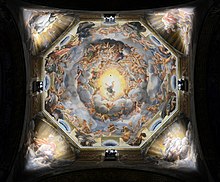
Some scholars argue that the Dormition and Assumption traditions can be traced early in church history in the apocryphal books, with Stephen J. Shoemaker stating:
For instance, Baldi, Masconi, and Cothenet analyzed the corpus of Dormition narratives using a rather different approach, governed primarily by language tradition rather than literary relations, and yet all agree that the Obsequies (i.e., the Liber Requiei Mariae) and the Six Books Dormition Apocryphon reflect the earliest traditions, locating their origins in the second or third century.[12]
According to Shoemaker, the first known narrative to address the end of Mary's life and her assumption is the apocryphal third- and possibly second-century Liber Requiei Mariae ("The Book of Mary's Repose").[13] Yet numerous features indicate that the Liber Requiei Mariae, or the Obsequies of the Virgin, as the text is called in Syriac, is even older than this ancient manuscript alone would suggest.[12]
Another early source that speaks of the Assumption is the "Six Books Dormition Apocryphon", so- called on account of its division into six separate books. It dates almost certainly to the middle of the fourth century, if not perhaps even earlier. [14] Most significantly, the Six Books Dormition Apocryphon provides compelling evidence for an early cult of the Virgin nearly a century before the events of the Council of Ephesus.[14]
The Greek Discourse on the Dormition or The Book of John Concerning the Falling Asleep of Mary (attributed to John the Theologian), is another anonymous narrative, and may even precede the Book of Mary's Repose.[15] This Greek document, is dated by Tischendorf as no later than the 4th century.[16][17] but is dated by Shoemaker as later.[18]
The New Testament is silent regarding the end of her life. In the late 4th century Epiphanius of Salamis wrote he could find no authorized tradition about how her life ended.[19] Nevertheless, although Epiphanius could not decide on the basis of biblical or church tradition whether Mary had died or remained immortal, his indecisive reflections suggest that some difference of opinion on the matter had already arisen in his time,[20] and he identified three beliefs concerning her end: that she had a normal and peaceful death; that she died as a martyr; or that she did not die.[20] Even more, in another text Epiphanius stated that Mary was like Elijah because she never died but was assumed, like him.[21]
Other works that mention the assumption of Mary are the apocryphal treatise De Obitu S. Dominae, bearing the name of St. John, which belongs however to the fourth or fifth century. It is also found in the apocryphal book De Transitus Beatae Mariae Virginis, falsely ascribed to Melito of Sardis, and in a spurious letter attributed to Denis the Areopagite.[22] [23]
The Euthymiac History, from the sixth century, is cited by John of Damascus, which narrates how Mary was assumed into heaven.[24]
John of Damascus set out what had become the standard Eastern tradition, that "Mary died in the presence of the Apostles, but that her tomb, when opened, upon the request of St Thomas, was found empty; wherefrom the Apostles concluded that her body was taken up to heaven."[25]
The feast of the Dormition, arrived in the West in the early 7th century, its name changing to Assumption in some 9th century liturgical calendars.[26] The feast was decreed for Constantinople on 15 August by the emperor Maurice in 600; about fifty years later it was introduced in Rome and is mentioned in a papal decree of Sergius (687-701), who fixed a procession for the feast.[27] Pope Leo IV (reigned 847–855) gave the feast a vigil and an octave to solemnise it above all others, Pope Nicholas I (858–867) placed it on a par with Christmas and Easter, and Pope Benedict XIV (1740–1758) declared it "a probable opinion, which to deny were impious and blasphemous".[28]
Scholars of the Studium Biblicum Franciscanum "argued that during or shortly after the apostolic age a group of Jewish Christians in Jerusalem preserved an oral tradition about the end of the Virgin's life". Thus, by pointing to oral tradition, they argued for the historicity of the assumption and Dormition narratives. According to Antoine Wenger "the strikingly diverse traditions of Mary's Dormition and Assumption arise from ‘a great variety of original types’, rather than being the result of a progressive modification of a single, original tradition". Simon Claude Mimouni and his predecessors have argued that belief in the Virgin's Assumption is the final dogmatic development, rather than the point of origin, of these traditions.[29]
There is a large number of accounts of assumption of the Virgin Mary, published in various languages (including Greek, Latin, Coptic, Syriac, Ethiopic, Arabic). The standard Greek text is the one attributed to St John the Theologian (Evangelist). The standard Latin is that attributed to Melito of Sardis.[30] Shoemaker mentions that "the ancient narratives are neither clear nor unanimous in either supporting or contradicting the dogma" of the assumption.[31]
Scriptural basis
[edit]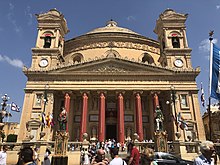
The apostolic constitution Munificentissimus Deus mentions several Holy Fathers, theologians and Doctors of the Church who held the Assumption of Mary, among them are Adrian I, Sergius I, Leo IV, John of Damascus, Amadeus of Lausanne, Modestus of Jerusalem, Anthony of Padua, Albertus Magnus, Thomas of Aquinas (Angelic Doctor), Bonaventure (Seraphic Doctor), Bernardino of Siena, Robert Bellarmine, Francis de Sales, Peter Canisius, Francisco Suárez, among others.[2] The apostolic constitution adds: "All these proofs and considerations of the holy Fathers and the theologians are based upon the Sacred Writings as their ultimate foundation."
Father Jugie, expressed the view that Revelation 12:1–2 was the chief scriptural witness to the assumption:[32]
And a great sign appeared in heaven: a woman clothed with the sun, and the moon under her feet, and on her head a crown of twelve stars; and she was with child ...
This passage, Epiphanius proposes, may indicate that Mary did not die as other human beings, but somehow remained immortal, although he makes clear his own uncertainty and refrains from advocating this view. Ultimately Epiphanius concludes: "[I] am not saying that she remained immortal. But neither am I affirming that she died."[33]
Since the time of the early Church Fathers, this image of "the woman clothed with the sun" has had a threefold symbolism: the ancient people of Israel, the Church and Mary.[34]
Many of the bishops cited Genesis 3:15, in which God is addressing the serpent in the Garden of Eden, as the primary confirmation of Mary's assumption:[35]
I will put enmity between you and the woman, and between your offspring and hers; he will strike your head, and you will strike his heel.
Many scholars connect Jesus' usage of the word "woman" to call Mary instead of calling her "mother" as a confirmation of Mary being the "woman" described in Genesis 3:15. Mary was often seen as the "New Eve", who crushed the serpent's head at the Annunciation by obeying the angel Gabriel when he said she would bear the Messiah (Luke 1:38).[36]
The Catechism of the Catholic Church affirms that the account of the fall in Genesis 3 uses figurative language, and that the fall of mankind, by the seductive voice of the snake in the Bible, represents the fallen angel, Satan or "the devil".[37] Similarly, the great dragon in Revelation 12 is a representation of Satan, identified with the serpent from the garden who has enmity with the woman.[38] Therefore, in Catholic thought, there is an association between this woman and Mary's Assumption.
Among the many other passages noted by Pope Pius XII were the following:[35]
- Psalm 132 (Psalm 132:8), greeting the return of the Ark of the Covenant to Jerusalem ("Arise, O Lord, into your resting place, you and the ark which you have sanctified!"), where the ark is taken as the prophetic "type" of Mary;[39]
- Revelation 11:19, in which John sees the Ark of the Covenant in heaven (this verse immediately precedes the vision of the woman clothed with the sun);
- Luke 1:28, in which the Archangel Gabriel greets Mary with the words, "Hail Mary, full of grace", since Mary's bodily assumption is a natural consequence of being full of grace;
- 1 Corinthians 15 (1 Corinthians 15:23) and Matthew 27 (Matthew 27:52–53), concerning the certainty of bodily resurrection for all who have faith in Jesus.
The Bible mentions two prominent figures, Enoch and Elijah, who were taken up to heaven, serving as important precedents for the assumption of Mary. Enoch, referenced in the Book of Genesis, is noted for his intimate walk with God and is described as having been "taken" by God (Genesis 5:24), an event that is also reported in the Epistle to the Hebrews (Hebrews 11:5). Similarly, Elijah, the great prophet, was taken up to heaven in a whirlwind, accompanied by a chariot of fire, as recorded in 2 Kings (2 Kings 2:11).
Catholic marian visionaries and the Assumption
[edit]In the 12th century, the German nun Elisabeth of Schönau was reportedly granted visions of Mary and her son which had a profound influence on the Western Church's tradition. In her work Visio de resurrectione beate virginis Mariae relates how Mary was assumed in body and soul into Heaven.[26] [40]
On 1 May 1950 Gilles Bouhours (a marian seer) reported to Pius XII a presumed message that the Virgin Mary would have ordered him to communicate to the pope on the dogma of the Assumption of the Holy Virgin Mary. It is said that Pius XII asked God, during the Holy Year of 1950, for a sign that could reassure him that the dogma of the Assumption of the Virgin Mary was actually wanted by God and when Gilles communicated the message to Pius XII, the pope considered this message the hoped-for sign. Six months after the private audience granted to Gilles by the pope, Pius XII himself proclaimed the dogma of the Assumption of body and soul of the Blessed Virgin Mary into Heaven.[41]
Assumption versus Dormition
[edit]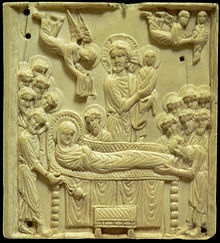
Some Catholics believe that Mary died before being assumed, but they believe that she was miraculously resurrected before being assumed (mortalistic interpretation). Others believe she was assumed bodily into Heaven without first dying (immortalistic interpretation).[42][43] Either understanding may be legitimately held by Catholics, with Eastern Catholics observing the Feast as the Dormition. It seems, however, that there is much more evidence for the mortalistic position in the Catholic traditions (liturgy, apocrypha, material culture).[44] Pope John Paul II expressed the mortalistic position in his public speech.[45]
Many theologians note by way of comparison that in the Catholic Church the Assumption is dogmatically defined, whilst in the Eastern Orthodox tradition the Dormition is less dogmatically than liturgically and mystically defined. Such differences spring from a larger pattern in the two traditions, wherein Catholic teachings are often dogmatically and authoritatively defined – in part because of the more centralized structure of the Catholic Church – whilst in Eastern Orthodoxy many doctrines are less authoritative.[46]
The Latin Catholic Feast of the Assumption is celebrated on 15 August and the Eastern Orthodox and Eastern Catholics celebrate the Dormition of the Mother of God (or Dormition of the Theotokos, the falling asleep of the Mother of God) on the same date, preceded by a 14-day fasting period. Eastern Christians believe that Mary died a natural death, that her soul was received by Christ upon death, that her body was resurrected after her death and that she was taken up into heaven bodily in anticipation of the general resurrection.
Orthodox tradition is clear and unwavering in regard to the central point [of the Dormition]: the Holy Virgin underwent, as did her Son, a physical death, but her body – like His – was afterwards raised from the dead and she was taken up into heaven, in her body as well as in her soul. She has passed beyond death and judgement and lives wholly in the Age to Come. The Resurrection of the Body ... has in her case been anticipated and is already an accomplished fact. That does not mean, however, that she is dissociated from the rest of humanity and placed in a wholly different category: for we all hope to share one day in that same glory of the Resurrection of the Body that she enjoys even now.[47]
Protestant views
[edit]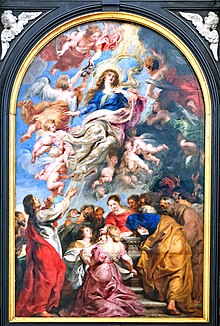
Views differ within Protestantism, with those with a theology closer to Catholicism sometimes believing in a bodily assumption whilst most Protestants do not.
Lutheran views
[edit]The Feast of the Assumption of Mary was retained by the Lutheran Church after the Reformation.[48] Evangelical Lutheran Worship designates August 15 as a lesser festival named "Mary, Mother of Our Lord" while the current Lutheran Service Book formally calls it "St. Mary, Mother of our Lord".[48]
Anglican views
[edit]Within Anglicanism the Assumption of Mary is accepted by some, rejected by others, or regarded as adiaphora ("a thing indifferent").[49] The doctrine effectively disappeared from Anglican worship in 1549, partially returning in Anglo-Catholic tradition during the 20th century under different names. A Marian feast on 15 August is celebrated by the Church of England as a non-specific feast of the Blessed Virgin Mary, a feast called by the Scottish Episcopal Church simply "Mary the Virgin",[50][51][52] and in the US-based Episcopal Church it is observed as the feast of "Saint Mary the Virgin: Mother of Our Lord Jesus Christ",[53] while other Anglican provinces have a feast of the Dormition[50] – the Anglican Church of Canada's Book of Common Prayer (1962), for instance, marks the day as the "Falling Asleep of the Blessed Virgin Mary".[54]
The Anglican-Roman Catholic International Commission, which seeks to identify common ground between the two communions, released in 2004 a non-authoritative declaration meant for study and evaluation, the "Seattle Statement"; this "agreed statement" concludes that "the teaching about Mary in the two definitions of the Assumption and the Immaculate Conception, understood within the biblical pattern of the economy of hope and grace, can be said to be consonant with the teaching of the Scriptures and the ancient common traditions".[55]
Other Protestant views
[edit]The Protestant reformer Heinrich Bullinger believed in the assumption of Mary. His 1539 polemical treatise against idolatry[56] expressed his belief that Mary's sacrosanctum corpus ("sacrosanct body") had been assumed into heaven by angels:
Hac causa credimus ut Deiparae virginis Mariae purissimum thalamum et spiritus sancti templum, hoc est, sacrosanctum corpus ejus deportatum esse ab angelis in coelum.[57] |
For this reason we believe that the Virgin Mary, Begetter of God, the most pure bed and temple of the Holy Spirit, that is, her most holy body, was carried to heaven by angels.[58] |
Feasts and related fasting period
[edit]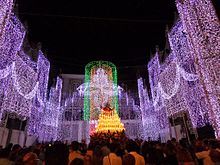
Orthodox Christians fast for fourteen days before the Feast of the Assumption of Mary, including abstinence from sexual relations.[59] Fasting in the Orthodox Churches generally consists of abstinence from certain food groups; during the Dormition fast, one observes a strict fast on weekdays, with wine and oil allowed on weekends and, additionally, fish on the Transfiguration (August 6).[60]
The Assumption is important to many Christians, especially Catholics and Orthodox, as well as many Lutherans and Anglicans, as the Virgin Mary's heavenly birthday (the day that Mary was received into Heaven). Belief about her acceptance into the glory of Heaven is seen by some Christians as the symbol of the promise made by Jesus to all enduring Christians that they too will be received into paradise. The Assumption of Mary is symbolised in the Fleur-de-lys Madonna.
The present Italian name of the holiday, Ferragosto, may derive from the Latin name, Feriae Augusti ("Holidays of the Emperor Augustus"),[61] since the month of August took its name from the emperor. The feast was introduced by Bishop Cyril of Alexandria in the 5th century. In the course of Christianization, he put it on 15 August. In the middle of August, Augustus celebrated his victories over Marcus Antonius and Cleopatra at Actium and Alexandria with a three-day triumph. The anniversaries (and later only 15 August) were public holidays from then on throughout the Roman Empire.[62]
The Solemnity of the Assumption on 15 August was celebrated in the Eastern Church from the 6th century. The Western Church adopted this date as a Holy Day of Obligation to commemorate the Assumption of the Blessed Virgin Mary, a reference to the belief in a real, physical elevation of her sinless soul and incorrupt body into Heaven.
Public holidays
[edit]This section needs additional citations for verification. (August 2017) |

Assumption Day on 15 August is a nationwide public holiday in Andorra, Austria, Belgium, Burundi, Cameroon, Central African Republic, Chile, Republic of Congo, Côte d'Ivoire, Croatia,[63] Colombia, Costa Rica, Cyprus, East Timor, France, Gabon, Greece, Georgia, Republic of Guinea, Haiti, Italy, Lebanon, Liechtenstein, Lithuania, Luxembourg, Republic of North Macedonia, Madagascar, Malta, Mauritius, Monaco, Montenegro (Albanian Catholics), Paraguay, Philippines (Maragondon, Cavite),Poland (coinciding with Polish Army Day), Portugal, Romania, Rwanda, Senegal, Seychelles, Slovenia, Spain, Syria, Tahiti, Togo, and Vanuatu;[64] and was also in Hungary until 1948.
It is also a public holiday in parts of Germany (parts of Bavaria and Saarland) and Switzerland (in 14 of the 26 cantons) and Bosnia (the Croatian zone). In Guatemala, it is observed in Guatemala City and in the town of Santa Maria Nebaj, both of which claim her as their patron saint.[65] Also, this day is combined with Mother's Day in Costa Rica and parts of Belgium.
Prominent Catholic, Eastern Orthodox, and Oriental Orthodox countries in which Assumption Day is an important festival but is not recognised by the state as a public holiday include the Czech Republic, Ireland, Mexico, the Philippines and Russia. In Bulgaria, the Feast of the Assumption is the biggest Eastern Orthodox Christian celebration of the Holy Virgin. Celebrations include liturgies and votive offerings. In Varna, the day is celebrated with a procession of a holy icon, and with concerts and regattas.[66]
In many places, religious parades and popular festivals are held to celebrate this day. In Canada, Assumption Day is the Fête Nationale of the Acadians, of whom she is the patroness saint. Some businesses close on that day in heavily francophone parts of New Brunswick, Canada. The Virgin Assumed in Heaven is also patroness of the Maltese Islands and her feast, celebrated on 15 August, apart from being a public holiday in Malta it is also celebrated with great solemnity in the local churches especially in the seven localities known as the Seba' Santa Marijiet. The Maltese localities which celebrate the Assumption of Our Lady are: Il-Mosta, Il-Qrendi, Ħal Kirkop, Ħal Għaxaq, Il-Gudja, Ħ'Attard, L-Imqabba and Victoria. The hamlet of Praha, Texas, holds a festival during which its population swells from approximately 25 to 5,000 people.
In Anglicanism and Lutheranism, the feast is now often kept, but without official use of the word "Assumption". In Eastern Orthodox churches following the Julian Calendar, the feast day of Assumption of Mary falls on 28 August.
Art
[edit]The earliest known use of the Dormition is found on a sarcophagus in the crypt of a church in Zaragoza in Spain dated c. 330.[23] The Assumption became a popular subject in Western Christian art, especially from the 12th century, and especially after the Reformation, when it was used to refute the Protestants and their downplaying of Mary's role in salvation.[67] Angels commonly carry her heavenward where she is to be crowned by Christ, while the Apostles below surround her empty tomb as they stare up in awe.[67] Caravaggio, the "father" of the Baroque movement, caused a stir by depicting her as a decaying corpse, quite contrary to the doctrine promoted by the church;[68] more orthodox examples include works by El Greco, Rubens, Annibale Carracci, and Nicolas Poussin, the last replacing the Apostles with putti throwing flowers into the tomb.[67]
See also
[edit]- Assumption, a disambiguation page which includes many places named after the Assumption of Mary
- Ascension of Jesus
- Coronation of Mary
- Resurrection of Jesus Christ
- Entering heaven alive
References
[edit]Citations
[edit]- ^ "Feast of the Assumption of the Holy Mother-of-God". The Armenian Church. Archived from the original on 16 August 2021. Retrieved 23 August 2021.
- ^ a b Pius XII (1 November 1950). "Munificentissimus Deus". Holy See.
- ^ Collinge 2012, p. 53.
- ^ Munificentissimus Deus, No. 42
- ^ Catechism of the Catholic Church #966. Retrieved 13 August 2024.
- ^ Meistermann, B. "CATHOLIC ENCYCLOPEDIA: Tomb of the Blessed Virgin Mary". www.newadvent.org. New York: Robert Appleton Company. Retrieved 10 September 2024.
- ^ Shoemaker, Stephen J. "(Ps.-)Joseph of Arimathea, The Passing of the Blessed Virgin Mary". Archived from the original on 13 April 2009. Retrieved 10 September 2024.
- ^ Ante-Nicene Fathers. The Writings of the Fathers Down to A.D. 325, vol. 8 p. 594
- ^ Alban Butler, Paul Burns (1998). Butler's Lives of the Saints. ISBN 0860122573. pp. 140–141
- ^ William Saunders (1996). "The Assumption of Mary". EWTN. Archived 16 June 2019 at the Wayback Machine
- ^ "The Dormition of the Mother of God – Saint Joseph Orthodox Church". Retrieved 13 August 2024.
- ^ a b Shoemaker, Stephen. "The Ancient Dormition Apocrypha and the Origins of Marian Piety: Early Evidence of Marian Intercession from Late Ancient Palestine (uncorrected page proofs)".
- ^ Shoemaker 2016, p. 24.
- ^ a b Shoemaker 2016, p. 25.
- ^ "Patrick Truglia, "Original Sin in The Byzantine Dormition Narratives" Revista Teologica, Issue 4 (2021): 9 (Footnote 30)" (PDF).
- ^ "Apocrypha of the New Testament", 'Introductory Notice to the Apocrypha of the New Testament, Vol 8, The Ante-Nicene Fathers.
- ^ "Philip Schaff: ANF08. The Twelve Patriarchs, Excerpts and Epistles, The Clementia, Apocrypha, Decretals, Memoirs of Edessa and Syriac Documents, Remains of the First Age - Christian Classics Ethereal Library". ccel.org. Retrieved 14 August 2024.
- ^ Patrick Truglia, "Original Sin in The Byzantine Dormition Narratives", Revista Teologica, Issue 4 (2021): 9 (Footnote 30).
- ^ Shoemaker 2002, pp. 11–12, 26.
- ^ a b Shoemaker 2002, p. 14.
- ^ Shoemaker, Stephen J. (2008). "Epiphanius of Salamis, the Kollyridians, and the Early Dormition Narratives: The Cult of the Virgin in the Fourth Century". Journal of Early Christian Studies 16 (3): 371–401. ISSN 1086-3184.
- ^ Holweck, Frederick (1907). CATHOLIC ENCYCLOPEDIA: Assumption of Mary. New York: Robert Appleton Company, 1907. Retrieved 30 July 2024.
- ^ a b Zirpolo 2018, p. 213.
- ^ John Wortley, "The Marian Relics at Constantinople", Greek, Roman, and Byzantine Studies 45 (2005), pp. 171–187, esp. 181–182.
- ^ Jenkins 2015, p. unpaginated.
- ^ a b Warner 2016, p. 91.
- ^ O'Carroll, Michael (1983). Theotokos: A Theological Encyclopedia of the Blessed Virgin Mary. Glazier. p. 55-57. ISBN 978-0-907271-11-6. Retrieved 27 October 2024.
- ^ Wagner 2020, p. 95.
- ^ Shoemaker 2002, pp. 18–20.
- ^ Elliott, J. K. (27 October 2005). The Apocryphal New Testament: A Collection of Apocryphal Christian Literature in an English Translation. Oxford: OUP Oxford. p. 691. ISBN 978-0-19-826181-0. Retrieved 15 August 2024.
- ^ Shoemaker 2002, p. 3.
- ^ O'Carroll 2000, p. 56.
- ^ Shoemaker 2002, p. 12.
- ^ Saunder, William (2004). "Woman Clothed with the Sun". Arlington Catholic Herald. Catholic Education Resource Center. Archived from the original on 13 July 2013. Retrieved 6 July 2011.
- ^ a b Miravalle 2006, p. 73.
- ^ Taylor, Edward K. (1961). "The Woman of Cana". The Furrow. 12 (5): 304–310. ISSN 0016-3120. JSTOR 27658099.
- ^ "Catechism of the Catholic Church – IntraText". Holy See. Retrieved 8 February 2022.
- ^ Williamson, Peter (2015). Catholic Christian Commentary on Sacred Scripture: Revelation. Grand Rapids, Michigan: Baker Academic. pp. 205–220. ISBN 978-0801036507.
- ^ "Assumption of Mary: Scriptural Support". University of Dayton, Ohio.
- ^ Clark, Anne L. (1992). Elisabeth of Schönau: a twelfth-century visionary. Philadelphia: University of Pennsylvania Press. p. 382. ISBN 9780812231236.
- ^ "Gilles Bouhours". Santiebeati.it. Retrieved 15 August 2023.
- ^ The Catholicism Answer Book: The 300 Most Frequently Asked Questions by John Trigilio, Kenneth Brighenti 2007 ISBN 1402208065 p. 64
- ^ Shoemaker 2016, p. 201
- ^ Witała, Maciej (16 December 2021). "Proposition of a Modern Theological Interpretation of Death as a Consequence of Sin". Poznańskie Studia Teologiczne. 39 (39): 40–41. doi:10.14746/pst.2021.39.02. ISSN 2451-2273.
- ^ John Paul II. "General Audience 25 June 1997". www.vatican.va. Retrieved 20 May 2023.
- ^ See "Three Sermons on the Dormition of the Virgin" by John of Damascus, from the Medieval Sourcebook
- ^ Bishop Kallistos (Ware) of Diokleia, in: Festal Menaion [London: Faber and Faber, 1969], p. 64.
- ^ a b Beane, Larry (15 August 2019). "The Feast of the Blessed Virgin Mary". Gottesdienst.org. Retrieved 27 May 2021.
Many early Lutherans retained the Feast of the Assumption in the liturgical calendar, while recognizing it as a speculation rather than a dogma. However, Pope Pius XII dogmatized this belief in 1950 in his decree Munificentissimus Dei (sic), thus imposing it as doctrine upon Roman Catholics. ... Today's feast is described in Lutheran Service Book as 'St. Mary, Mother of our Lord'.
- ^ Williams, Paul (2007). pp. 238, 251, quote: "Where Anglican writers discuss the doctrine of the Assumption, it is either rejected or held to be of the adiaphora."
- ^ a b Williams, Paul (2007). p. 253, incl. note 54.
- ^ The Church of England, official website: The Calendar. Accessed 17 July 2018
- ^ The Scottish Episcopal Church, official website: Calendar and Lectionary. Accessed 17 July 2018
- ^ The Episcopal Church. "Saint Mary the Virgin: Mother of Our Lord Jesus Christ". Liturgical Calendar. New York: The Domestic and Foreign Missionary Society, The Episcopal Church. Archived from the original on 17 July 2018. Retrieved 17 July 2018.
- ^ "The Calendar". Prayerbook.ca. p. ix. Archived from the original on 4 November 2013. Retrieved 3 November 2013.
- ^ "Mary: Grace and Hope in Christ". Vatican.va. 26 June 2000. Retrieved 3 November 2013.
There is no direct testimony in Scripture concerning the end of Mary's life. However, certain passages give instances of those who follow God's purposes faithfully being drawn into God's presence. Moreover, these passages offer hints or partial analogies that may throw light on the mystery of Mary's entry into glory.
- ^ De origine erroris libri duo [On the Origin of Error, Two Books] [1]. "In the De origine erroris in divorum ac simulachrorum cultu he opposed the worship of the saints and iconolatry; in the De origine erroris in negocio Eucharistiae ac Missae he strove to show that the Catholic conceptions of the Eucharist and of celebrating the Mass were wrong. Bullinger published a combined edition of these works in 4 ° (Zurich 1539), which was divided into two books, according to themes of the original work." The Library of the Finnish nobleman, royal secretary and trustee Henrik Matsson (c. 1540–1617), Terhi Kiiskinen Helsinki: Academia Scientarium Fennica (Finnish Academy of Science), 2003, ISBN 978-9514109447, p. 175
- ^ Froschauer. De origine erroris, Caput XVI (Chapter 16), p. 70
- ^ The Thousand Faces of the Virgin Mary (1996), George H. Tavard, Liturgical Press ISBN 978-0814659144, p. 109. [2]
- ^ Menzel, Konstantinos (14 April 2014). "Abstaining From Sex Is Part of Fasting". Greekreporter.com. Greek Reporter. Retrieved 27 May 2021.
- ^ "The Fasting Seasons | Antiochian Orthodox Christian Archdiocese".[dead link]
- ^ Pianigiani, Ottorino (1907). "Vocabolario etimologico della lingua italiana".
- ^ Giebel, Marion (1984). Augustus. Reinbek bei Hamburg: Rowohlt. p. 6. ISBN 3499503271.
- ^ "Zakon o blagdanima, spomendanima i neradnim danima u Republici Hrvatskoj". Narodne novine (in Croatian). 14 November 2019. Retrieved 28 August 2024.
- ^ Columbus World Travel Guide, 25th ed.
- ^ Reiland, Catherine. "To Heaven Through the Streets of Guatemala City: the Processions of the Virgin of the Assumption". Emisferica. Archived from the original on 22 December 2016. Retrieved 11 June 2018.
- ^ "The Assumption of Mary into Heaven, the most revered summer Orthodox Christian feast in Bulgaria". bnr.bg.
- ^ a b c Zirpolo 2018, p. 83.
- ^ Zirpolo 2018, pp. 213–214.
Bibliography
[edit]- Alter, Robert (1997). Genesis: Translation and Commentary. W. W. Norton & Company. ISBN 978-0393070262.
- Arnold, Bill T. (2009). Genesis. Cambridge University Press. ISBN 978-0521000673.
- Beale, G. K.; Campbell, David (2015). Revelation: A Shorter Commentary. Eerdmans. ISBN 978-0304707812.
- Boss, Sarah Jane (2000). Empress and Handmaid: On Nature and Gender in the Cult of the Virgin Mary. A&C Black. ISBN 978-0304707812.
- Collinge, William J. (2012). Historical Dictionary of Catholicism. Scarecrow Press. ISBN 978-0810879799.
- Cross, Frank Leslie; Livingstone, Elizabeth A. (2005). "Assumption of the BVM". The Oxford Dictionary of the Christian Church. Oxford University Press. ISBN 978-0192802903.
- Duffy, Eamon (1989). What Catholics Believe About Mary. London: Catholic Truth Society.
- Ford, John T. (2006). Saint Mary's Press Glossary of Theological Terms. Saint Mary's Press. ISBN 978-0884899037.
- Goldingay, John (2020). Genesis. Baker Academic. ISBN 978-1493423972.
- Jenkins, Philip (2015). The Many Faces of Christ. Hachette. ISBN 978-0465061617.
- Kerr, W.N. (2001). "Mary, Assumption of". In Elwell, Walter A. (ed.). Evangelical Dictionary of Theology. Baker Academic. ISBN 978-0801020759.
- Miravalle, Mark I. (2006). Introduction to Mary: The Heart of Marian Doctrine and Devotion. Queenship Publishing. ISBN 9781882972067.
- O'Carroll, Michael (2000). Theotokos: A Theological Encyclopedia of the Blessed Virgin Mary. Wipf and Stock. ISBN 978-1579104542.
- Shoemaker, Stephen J. (2016). Mary in Early Christian Faith and Devotion. Yale University Press. ISBN 978-0300217216.
- Shoemaker, Stephen J. (2002). Ancient Traditions of the Virgin Mary's Dormition and Assumption. Oxford University Press. ISBN 978-0199250752.
- Wagner, David M. (2020). The Church and the Modern Era (1846–2005). Ave Maria Press. ISBN 978-1594717888.
- Warner, Marina (2016). Alone of All Her Sex. Oxford University Press. ISBN 978-0198718789.
- Williams, Paul (2019). "The English Reformers and the Blessed Virgin Mary". In Maunder, Chris (ed.). The Oxford Handbook of Mary. Oxford University Press. ISBN 978-0198792550.
- Zirpolo, Lilian H. (2018). Historical Dictionary of Baroque Art and Architecture. Rowman & Littlefield. ISBN 978-1538111291.
Further reading
[edit]- Duggan, Paul E. (1989). The Assumption Dogma: Some Reactions and Ecumenical Implications in the Thought of English-speaking Theologians. Emerson Press, Cleveland, Ohio.[ISBN missing]
- Hammer, Bonaventure (1909). . Mary, help of Christians. Benziger Brothers.
- Mimouni, Simon Claude (1995). Dormition et assomption de Marie: Histoire des traditions anciennes. Beauchesne, Paris. [ISBN missing]
- Salvador-Gonzalez, José-María (2019). "Musical Resonanes in the Assumption of Mary and Their Reflection in the Italian Trecento and Quattrocento Painting". Music in Art: International Journal for Music Iconography. 44 (1–2): 79–96. ISSN 1522-7464.
External links
[edit]- "Munificentissimus Deus – Defining the Dogma of the Assumption" Vatican, 1 November 1950
- Footage of the Assumption proclamation (1950) (British Pathé)
- "The Book of John Concerning the Falling Asleep of Mary, attributed to John the Theologian". Uoregon.edu. Archived from the original on 31 August 2009. Retrieved 3 November 2013.
- "De Transitus Beatae Mariae Virginis (the Passing of the Blessed Virgin Mary), attributed to Melito of Sardis". Uoregon.edu. Archived from the original on 13 April 2009. Retrieved 3 November 2013.

